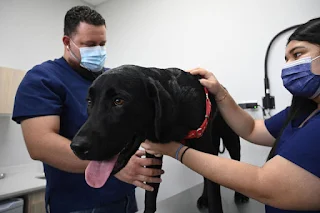The Rise of Online Pet Adoption Sites
The internet has revolutionized the way we live our lives, and pet adoption is no exception. In the past, those who were interested in adopting a furry friend had to rely on their local animal shelters or pet stores.
However, with the advent of online pet adoption sites, prospective adopters have a wider range of pets to choose from and can easily find their perfect match with just a few clicks. The first online pet adoption site was launched in 1995 by Eric Borgos.
The website known as "Petfinder" quickly gained popularity among animal lovers and rescue organizations alike. Petfinder allowed for rescues to list available animals on the site for free, which helped connect them with potential adopters across the country.
Today, Petfinder has over 3000 animal shelters and rescue organizations listed on its website. The importance of pet adoption cannot be overstated.
According to the American Society for the Prevention of Cruelty to Animals (ASPCA), approximately 6.5 million companion animals enter U.S shelters every year. Without adoption, these animals may face euthanasia or live in cramped conditions for extended periods of time.
Adoption through online sites has become incredibly popular over recent years due to its convenience and accessibility. The ability to browse through hundreds if not thousands of pets from different states in one sitting is highly appealing compared to going from store-to-store looking at individual pets that are usually expensive - especially if you're looking for specific breeds or exotic species that are harder to find locally.
What is Pet Adoption?
Pet adoption is where people welcome dogs, cats or other pets into their families by taking them from care centers such as animal shelters or rescues instead of buying them from pet stores and breeders. Adoption centers work to ensure that their pets are well-fed, cared for and medically attended to before being adopted.
After adoption, owners may receive training and advice on how to take care of their pets properly. While adoption is a great way to provide homes for animals in need, it’s not only about giving pets a roof over their heads.
Pets offer many benefits to their owners; they can provide companionship, reduce stress levels, aid in depression and anxiety reduction, offer exercise opportunities through playing or walking with them. Studies have also shown that owning a pet can lead to lower blood pressure levels among other health benefits.
Adopting a pet is an important decision, and one that should be taken seriously. It's vital that you consider your lifestyle when trying to choose the right pet for your family; whether you are looking for an active dog or a cat who prefers lounging indoors - there is always an animal suited towards your lifestyle.
Adopting pets online has become increasingly popular over the years as technology continues advancing. Pet adoption sites provide an easy and accessible way of finding animals in need of loving homes while also offering numerous benefits for adopters themselves such as improved mental health and physical fitness levels.
Overview of Popular Pet Adoption Sites
Some of the most well-known pet adoption sites include:
Petfinder: Arguably the most recognizable name in online pet adoptions, Petfinder boasts over 11,000 animal shelters and rescue organizations from across the United States, Canada, and Mexico. Users can search by location, breed, age, gender and more.
Adopt-a-Pet: A similar site to Petfinder that also allows users to search by location and breed preferences. Adopt-a-Pet’s unique feature is their “Best Match” option that pairs pets with potential adopters based on compatibility.
Petango: Another site that partners with animal welfare organizations across North America to connect pets in need with caring families. One standout feature is their use of machine learning algorithms to match pets with potential adopters based on personality traits.
Comparison of Features and Services Offered by Each Site
Each site has its own strengths and weaknesses when it comes to features and services offered. For example:
Petfinder: Offers a robust search engine with a wide range of parameters for finding your perfect pet. Also provides resources such as articles on training tips and advice for first-time pet owners.
Adopt-a-Pet: Provides a user-friendly interface and unique “Best Match” option for finding compatible pets. Also offers resources such as articles on nutrition and wellness tips.
Petango: Offers machine-learning algorithms to help match pets with adopters based on personalities. Provides users with a seamless experience across desktop and mobile devices.
Tips for finding the right pet on adoption sites
Adopting a new pet is an exciting time, but it can also be overwhelming. With so many adorable pets to choose from on pet adoption sites, it's easy to get lost in the sea of options.
Here are some tips for finding the perfect furry friend:
1. Narrow down your search: When browsing adoption sites, use filters to narrow down your search based on animal type, breed, age, and location. This will help you focus your search and find pets that meet your specific criteria.
2. Read the animal's profile carefully: Each animal has their own unique personality and needs. Read their profile thoroughly to get a sense of what they're like and if they would be a good fit for your lifestyle.
3. Look for photos and videos: Photos can give you an idea of what the animal looks like, but videos can provide more insight into their personality and behavior.
4. Consider special needs pets: Don't overlook animals with special needs or medical conditions. They may require extra care, but they also have so much love to give and deserve a chance at a happy life.
Understanding the adoption process and requirements
The adoption process can vary depending on which site or organization you use, but here are some general requirements you should be aware of:
1. Adoption application: Most adoption processes begin with filling out an application form that includes basic information about yourself, living situation, and previous pet experience.
2. Home visit: Some organizations may require a home visit before approving an adoption to ensure that your home is suitable for the chosen pet.
3. Fees: Adoption fees vary based on where you adopt from and which animal you choose.
4. Post-adoption follow-up visits: Some organizations may conduct follow-up visits after the adoption to ensure that everything is going well with both the pet and their new family.
It's important to remember that the adoption process is in place to ensure that pets are placed in loving and appropriate homes. Be patient and honest throughout the process, and you'll soon find yourself with a new furry family member who will bring joy into your life.
Benefits of Adopting Pets Online
Convenience and accessibility
One of the major benefits of adopting pets online is how easy it is to browse different adoption sites from the comfort of your own home. Instead of visiting multiple animal shelters or breeders in person, you can simply use the internet to find a wide range of pets available for adoption. This convenience makes it much easier for people with busy schedules or those who live in remote areas to find and adopt a pet.
Additionally, many pet adoption sites offer advanced search options that allow you to refine your search by location, breed, age, gender, and other criteria. This makes it easier than ever before to find a pet that fits your lifestyle and preferences.
Wider variety of pets available
Another advantage of adopting pets online is that you have access to a much wider variety of animals than you might be able to find at local shelters or breeders. Many online adoption sites work with animal rescue organizations across the country, which means they can offer more diverse breeds and species than traditional brick-and-mortar shelters.
In addition, some pet adoption sites partner with international organizations to bring in animals from other countries. This gives adopters the chance to give homes to animals that may have been abandoned or mistreated in their original homes overseas.
Cost savings compared to buying from breeders
Adopting a pet through an online site can also be a more affordable option than buying from a breeder. While many reputable breeders charge premium prices for their purebred animals, most animal shelters and rescue organizations only require an adoption fee covering basic medical expenses like vaccinations and spaying/neutering surgeries.
Additionally, some online adoption sites offer promotions or discounts on certain pets if they’ve been waiting for their forever home longer than others. Adopting these furry friends not only brings joy to the adopter but also helps these animals find a loving home and reduces overcrowding in shelters.
It’s important to keep in mind that adopting an animal is a serious commitment that should not be taken lightly. However, if you’re ready for the responsibility and love that comes with owning a pet, adopting one through an online site can be a rewarding experience for both you and your new furry friend.
Challenges and Risks
Scams and frauds
While there are many reputable pet adoption sites online, there are also scams and fraudulent activities that you need to watch out for.
One common scam is the "puppy mill" scam, where the seller claims the pets are from a reputable breeder but in reality, they come from a puppy mill.
Another scam is the "deposit" scam where the seller will demand a deposit before sending you the pet, but then disappear once they have your money.
To avoid scams, make sure to do your research and only work with reputable adoption sites.
Read reviews and check their reputation online. Don't be afraid to ask questions or follow up on any doubts or concerns you may have.
Potential health or behavioral issues
Adopting a pet online comes with potential health or behavioral issues that you need to be aware of. Adopted pets may have underlying medical conditions that were not disclosed by the site or previous owner.
They may also have behavioral issues due to past experiences or lack of training. To minimize these risks, it's recommended that you adopt from a site that provides detailed information about each pet's medical history and behavior.
You can also request for a vet checkup before finalizing your adoption. It's important to remember that adopting a pet requires patience, understanding, and some level of commitment as they adjust to their new environment.
It’s important to note that even if an animal appears healthy upon adoption day doesn't mean they don't need to see a vet soon after. Cats and dogs need to be vaccinated, tested for parasites such as heartworm or tick-borne diseases, and spayed or neutered if not already done so before adoption.
While there are certainly risks involved with adopting pets online, you can minimize those risks by doing your due diligence beforehand. By being vigilant and informed about potential scams and health/behavioral issues that may arise with an adopted pet, you'll be better prepared to provide a loving home for your new furry friend.
Success Stories
Love at First Sight: A Rescue Dog's Happy Ending
Maggie was just a tiny puppy when she was found wandering on the streets by a rescue organization. She was malnourished, covered in fleas and ticks, and had scars all over her body from past injuries.
It was clear that she had been neglected and mistreated by her previous owners. Her story touched the heart of a young couple who were browsing pet adoption sites online.
The couple immediately fell in love with Maggie's big, adoring eyes and playful personality. They decided to adopt her and give her the loving home she deserved.
After a few weeks of care and attention, Maggie started to transform into a happy, healthy dog. She gained weight, grew back her fur, and became more confident around people.
Today, Maggie is thriving with her new family who can't imagine life without her. The couple says that adopting Maggie has been one of the best decisions they've ever made.
A Cat's Second Chance at Life
Toby was a senior cat who had spent most of his life in a shelter waiting for someone to adopt him. He had been passed over many times due to his age and health issues, but that didn't stop one woman from falling in love with him on an adoption site.
The woman knew that older cats often have trouble getting adopted because people prefer younger ones. But she also knew that Toby deserved a chance at happiness in his golden years too.
After bringing Toby home, it wasn't long before he started showing his sweet and affectionate personality. He loved curling up next to his new owner on the couch for long naps or playing with toys together.
Toby's new owner says that adopting him has been one of the most rewarding experiences of her life. She's grateful for the opportunity to give a senior cat a second chance at life and hopes that others will consider adopting older pets too.
A Dog's Life-Saving Adoption
When a young family was browsing pet adoption sites online, they stumbled upon a dog named Rocky who had been rescued from an abusive home. Rocky was suffering from multiple injuries and trauma from his past experiences, but he still managed to wag his tail and show affection to anyone who approached him.
The family knew that adopting Rocky would be a challenge, but they also knew that he deserved love and care just like any other pet. They took him home and started working with trainers to help him overcome his fears and anxieties.
Over time, Rocky became more confident and playful with his new family. He learned how to trust people again and even made friends with other dogs in the neighborhood.
The family says that adopting Rocky has not only changed their lives but also saved his life. He's now a happy and healthy dog who loves to go on walks, play fetch, and cuddle with his favorite humans.
Adopting Pets Online: A Win-Win Situation
These success stories are just a few examples of how pet adoption sites online can make a positive impact on both pets' lives and adopters' lives. By choosing adoption over buying from breeders or pet stores, you're giving animals in need a second chance at happiness while also gaining an incredibly loyal companion.
Plus, many adoption sites offer resources such as training tips, behavioral advice, and medical support to help ensure successful adoptions. It's truly a win-win situation for everyone involved!
As you can see, there are numerous benefits to adopting a pet through an online adoption site. You get convenience and accessibility while saving money compared to buying from breeders. Plus, you get access to a wider variety of pets that may not be available locally.
But most importantly, by choosing to adopt a pet instead of buying one from a breeder or store, you are helping rescue an animal in need of love and care. Your actions will make an enormous difference in their lives - giving them comfort and security they may never had otherwise experienced.
So if you're thinking about adding to your family dynamic or know someone who is considering it themselves - consider adopting through one these amazing websites! Not only will it change your life for the better - but it will change theirs too!








































.jpg)
.jpg)
.jpg)
.jpg)
.jpg)

